Are you ready to make your house more eco-friendly? In this article, we’ll show you how to create an environmentally conscious home that reduces your carbon footprint and saves you money. By choosing sustainable materials, energy-efficient lighting solutions, and implementing renewable energy sources, you can create a space that is not only beautiful but also good for the planet. With simple strategies like water conservation methods and waste reduction techniques, you can make a positive impact on the environment while enjoying a healthy indoor living space. Let’s get started!
Choosing Sustainable Materials
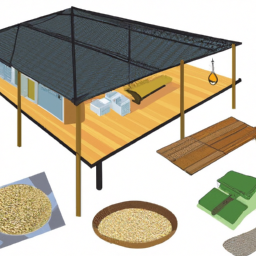
When choosing sustainable materials for your eco-friendly house, it’s important to consider their environmental impact. By opting for sustainable building techniques and eco-conscious construction methods, you can reduce the negative effects on the environment while creating a comfortable and energy-efficient home.
One key aspect of sustainable building is using materials that are renewable and have a low carbon footprint. For example, bamboo is a popular choice due to its fast growth rate and abundance. It can be used for flooring, furniture, and even structural elements in your house. Another option is reclaimed wood, which not only adds character to your home but also reduces the demand for new timber.
In addition to considering the source of materials, it’s crucial to prioritize energy efficiency. Opt for insulation made from recycled materials or natural fibers like wool or cellulose. These provide excellent thermal performance while minimizing heat loss or gain in your home.
Furthermore, explore alternatives to traditional cement such as rammed earth or compressed earth blocks. These techniques use locally sourced soil mixed with stabilizers like clay or lime, resulting in durable walls that require minimal energy during production.
Energy-Efficient Lighting Solutions
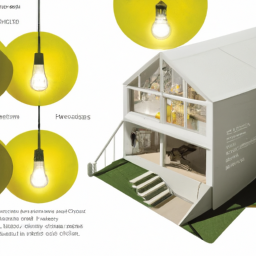
Switching to energy-efficient lighting solutions can significantly reduce your electricity consumption. By incorporating smart technology and natural daylighting into your home, you can create a more eco-friendly and sustainable living space.
Smart technology plays a crucial role in energy efficiency. With the help of smart lighting systems, you can control and automate your lights based on occupancy or time schedules. This means that lights will only be used when necessary, reducing unnecessary energy waste. Additionally, smart bulbs are designed to consume less electricity while providing the same level of brightness as traditional incandescent bulbs.
Natural daylighting is another effective way to save energy. Maximizing natural light not only reduces the need for artificial lighting but also creates a healthier and inviting atmosphere indoors. Consider installing skylights or large windows in rooms where sunlight is abundant. You can also use light-colored walls and reflective surfaces to enhance natural light distribution throughout your home.
When choosing energy-efficient lighting solutions, opt for LED bulbs as they are highly efficient and have a longer lifespan compared to other options. Moreover, LED bulbs do not contain harmful substances such as mercury which makes them safer for both the environment and your health.
Water Conservation Methods
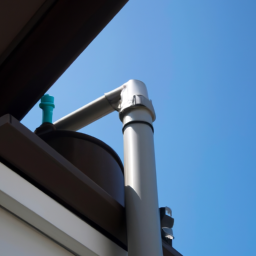
Water conservation methods involve implementing strategies to reduce water usage and promote sustainability in our daily activities. By adopting practical techniques such as rainwater harvesting and installing low flow fixtures, you can make a significant impact on your water consumption.
Rainwater harvesting is an effective method that allows you to capture rainwater for various purposes. Installing a rain barrel or cistern can collect the water runoff from your roof, which can then be used for gardening, irrigation, or even flushing toilets. This not only reduces your reliance on treated tap water but also helps alleviate the strain on local water supplies.
Another way to conserve water is by replacing traditional fixtures with low flow alternatives. Low flow showerheads and faucets are designed to limit the amount of water flowing through them without compromising performance. These fixtures often use aerators or pressure regulators to create a steady stream while using less water. By making this simple switch, you can save gallons of water per day without sacrificing comfort.
Incorporating these methods into your daily routine will not only contribute towards environmental preservation but also lead to substantial cost savings over time. So why not take action today and start conserving one of our most valuable resources?
Implementing Renewable Energy Sources
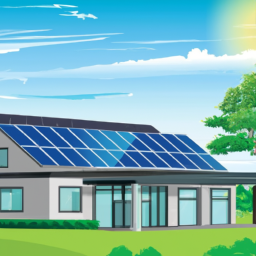
By incorporating renewable energy sources into your home, you can reduce your carbon footprint and decrease reliance on non-renewable resources. One effective way to do this is by installing solar panels on your roof. Solar panels harness the power of the sun and convert it into electricity that can be used to power your home. With advancements in technology, solar panels have become more efficient and affordable, making them a viable option for homeowners.
When considering solar panel installation, it’s important to assess the suitability of your property. Ideally, you should have a south-facing roof with little to no shading from trees or buildings. Additionally, the angle of your roof should be optimized for maximum sun exposure throughout the day.
Another renewable energy source to consider is wind turbines. Wind turbines use the power of wind to generate electricity. They can be installed in open areas with consistent wind flow. However, it’s important to check local regulations and restrictions before implementing wind turbines as they may require specific permits and clearances.
Incorporating solar panels and wind turbines into your home not only reduces your environmental impact but also provides long-term financial benefits through reduced energy bills and potential government incentives. So why not take advantage of these renewable energy options today? Start reducing your carbon footprint while enjoying clean, sustainable energy for years to come!
Insulation and Thermal Efficiency
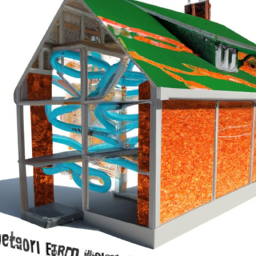
Installing proper insulation in your home can significantly improve its thermal efficiency and help reduce energy consumption. When it comes to energy-saving techniques and eco-friendly construction, insulation plays a crucial role. By preventing heat transfer through walls, roofs, floors, and windows, insulation helps maintain a comfortable indoor temperature while reducing the need for heating or cooling systems.
To maximize the benefits of insulation, consider using eco-friendly materials such as recycled denim, cellulose fiber made from recycled newspaper, or natural fibers like sheep’s wool. These options not only provide excellent insulation but also minimize environmental impact.
When insulating your home, make sure to seal any gaps or cracks that could allow air leakage. This will further enhance your home’s energy efficiency by preventing drafts and heat loss.
Proper insulation also contributes to noise reduction. It acts as a barrier against external sounds, creating a more peaceful living environment inside your home.
In addition to installing high-quality insulation materials throughout your house, it is essential to consider the R-value—the measure of an insulation material’s thermal resistance—when making choices. The higher the R-value, the better the insulating properties.
Eco-Friendly Landscaping and Garden Design
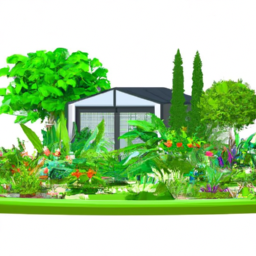
To create a sustainable and beautiful outdoor space, you can incorporate eco-friendly landscaping and garden design into your yard. One way to achieve this is through rainwater harvesting. By collecting rainwater from your roof or other surfaces, you can store it in barrels or underground tanks for later use in watering your plants and gardens. This not only conserves water but also reduces stormwater runoff, which can help prevent erosion and pollution of nearby water sources.
Another important aspect of eco-friendly landscaping is the use of native plant species. Native plants are well adapted to the local climate and require less water, fertilizer, and pesticides compared to non-native species. They also provide habitat for native wildlife such as birds and butterflies. When selecting plants for your yard, choose those that are native to your region to promote biodiversity and enhance the overall health of your ecosystem.
In addition to rainwater harvesting and native plant species, consider incorporating other sustainable practices into your landscaping design. These may include using organic mulch to conserve moisture, practicing proper irrigation techniques like drip irrigation to minimize water waste, composting yard waste instead of sending it to landfills, and creating habitat areas with rocks or logs for beneficial insects.
Waste Reduction and Recycling Strategies
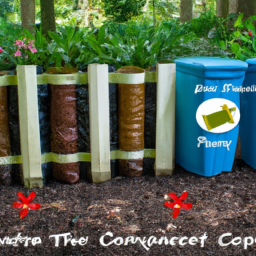
Consider implementing waste reduction and recycling strategies in your yard to minimize the amount of waste that goes to landfills and promote a more sustainable environment. By adopting composting practices, you can turn organic waste such as kitchen scraps, leaves, and grass clippings into nutrient-rich soil for your garden. Composting is an easy and effective way to reduce landfill waste while improving the health of your plants. Start by designating a composting area in your yard where you can pile up these materials. Turn the pile regularly to help with decomposition, and ensure that it stays moist but not soggy.
Another eco-friendly strategy is upcycling techniques. Instead of throwing away old items, find creative ways to repurpose them in your yard. For example, old wooden pallets can be transformed into raised beds or vertical planters for growing herbs or flowers. Broken clay pots can be turned into charming mosaic decorations or used as drainage material in larger pots. By giving new life to these items, you not only reduce waste but also add unique touches to your outdoor space.
Incorporating these waste reduction and recycling strategies into your yard will not only benefit the environment but also save you money on gardening supplies. So why wait? Start composting and upcycling today for a greener and more sustainable yard!
Creating a Healthy Indoor Environment

Now that you have implemented waste reduction and recycling strategies in your eco-friendly house, it’s time to focus on creating a healthy indoor environment. One crucial aspect of this is ensuring good indoor air quality. Poor air quality can lead to various health issues, such as respiratory problems, allergies, and even asthma.
To improve the indoor air quality in your home, consider using green cleaning products. Traditional cleaning products often contain harmful chemicals that can linger in the air long after you’ve cleaned. By switching to environmentally friendly options, you can minimize your exposure to these toxins and create a safer space for yourself and your family.
Green cleaning products are made from natural ingredients that are non-toxic and biodegradable. They are free from harsh chemicals like ammonia, chlorine bleach, and formaldehyde. Look for eco-labels or certifications like Green Seal or EPA Safer Choice when choosing cleaning products.
Additionally, try to open windows regularly to allow fresh air circulation throughout your home. This will help remove any pollutants or stale air trapped inside.
Frequently Asked Questions
What Are Some Common Misconceptions About Choosing Sustainable Materials for an Eco-Friendly House?
Common misconceptions about choosing sustainable materials for an eco-friendly house include the belief that they are expensive and not aesthetically pleasing. However, this isn’t true. Sustainable materials can be cost-effective in the long run due to their durability and energy-saving properties. Additionally, there is a wide range of stylish sustainable options available today that can enhance the beauty of your home while also benefiting the environment. So don’t let these misconceptions deter you from making a greener choice for your house.
How Can I Calculate the Energy Savings and Cost-Effectiveness of Different Energy-Efficient Lighting Solutions?
To calculate the energy savings and cost-effectiveness of different energy-efficient lighting solutions, start by comparing their wattage and lifespan. Look for options with lower wattage and longer lifespan to save on electricity bills over time. Next, consider the initial cost of each solution and divide it by the estimated energy savings per year. This will give you a measure of their cost-effectiveness. Remember to also factor in any rebates or incentives available in your area to further maximize savings.
Are There Any Government Incentives or Tax Credits Available for Implementing Renewable Energy Sources in an Eco-Friendly House?
Government incentives and tax credits can significantly help you in implementing renewable energy sources in your eco-friendly house. There are various programs available that offer financial support for adopting sustainable technologies. These incentives and credits can offset the initial costs of installing solar panels, geothermal systems, or other renewable energy solutions. It’s important to research and stay updated on the specific programs offered by your local government or utility company, as they may have different eligibility requirements and application processes.
What Are Some Innovative Insulation and Thermal Efficiency Techniques That Can Be Used to Reduce Energy Consumption?
To reduce energy consumption in your eco-friendly house, consider using innovative insulation materials and implementing smart home energy management systems. Innovative insulation materials like aerogel or recycled denim can provide excellent thermal efficiency and help keep your home comfortable year-round. Additionally, a smart home energy management system can monitor and control your energy usage, optimizing it for maximum efficiency. By combining these techniques, you can significantly reduce your energy consumption and create a more sustainable living space.
Can You Provide Tips on How to Create an Eco-Friendly Garden Design That Attracts Pollinators and Promotes Biodiversity?
To create an eco-friendly garden design that attracts pollinators and promotes biodiversity, consider incorporating sustainable landscaping practices. Start by selecting native plants that are adapted to your region’s climate and soil conditions. These plants will require less water and maintenance compared to non-native species. Create diverse habitats by including a variety of flowering plants, trees, shrubs, and grasses. Provide food sources like nectar-rich flowers for pollinators and shelter for beneficial insects. Avoid using chemical pesticides and fertilizers that can harm wildlife.
Conclusion
In conclusion, creating an eco-friendly house is within your reach and can have a significant positive impact on the environment. By choosing sustainable materials, implementing energy-efficient lighting solutions, conserving water, utilizing renewable energy sources, improving insulation and thermal efficiency, designing an eco-friendly landscape and garden, reducing waste through recycling strategies, and creating a healthy indoor environment, you can create a home that not only saves you money but also contributes to a greener future. Start making these changes today and be proud of your contribution towards sustainability.